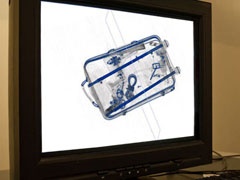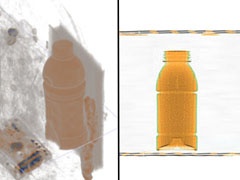 We’ve said it before and we’ll say it again – Today’s X-ray systems are currently in their most stable form and they’ll be around for quite some time. The screening technology is reliable and has proven to be effective when used by trained X-ray operators for threat detection. Currently, there is no technology existing in the market to replace conventional X-ray in terms of cost and speed.
We’ve said it before and we’ll say it again – Today’s X-ray systems are currently in their most stable form and they’ll be around for quite some time. The screening technology is reliable and has proven to be effective when used by trained X-ray operators for threat detection. Currently, there is no technology existing in the market to replace conventional X-ray in terms of cost and speed.
Manufacturers have even started to develop 3D imaging technology to integrate into their systems – thus extending the life of conventional X-ray further. This technology brings flat 2D X-ray images to life by giving them depth while providing a comprehensive overview of screened baggage and cargo for 3D image interpretation.
2D vs. 3D X-ray Imaging
Two-dimensional images give the appearance of looking directly at an object head on. From this perspective, an X-ray image in 2D will only have length and width. When viewing an X-ray image in 2D, all depths are represented in one view. Therefore, it’s difficult to distinguish the densities of individual items when they are overlapping, especially if there isn’t a second view (dual view) available.
In comparison, an X-ray image in 3D will have length, width, and height. The extra dimension gives depth and a better perspective of scanned items. 3D X-ray imaging makes it easier to determine the relative position of objects in relation to each other. It also makes it possible to take a cross section slice of the image to examine bags and cargo in detail. Security screeners can then determine if threat objects or prohibited items are present.
Making the Transition
 It’s a big adjustment for X-ray operators to switch from 2D to 3D X-ray interpretation. Your screeners need help transitioning and a lot of that falls onto proper training. Ensure your screeners develop the skills required to analyze 3D images.
It’s a big adjustment for X-ray operators to switch from 2D to 3D X-ray interpretation. Your screeners need help transitioning and a lot of that falls onto proper training. Ensure your screeners develop the skills required to analyze 3D images.
Screeners will need to develop their visual spatial ability and object depth localization skills. Being able to mentally rotate objects around an imaginary axis is an ability that must be honed as is the ability to locate an object and determine how close it is to another.
Constant practice in a simulator can help 3D X-ray operators grow accustom to the new inspection system. The simulator must emulate the actual system by providing the ability to rotate baggage and cargo to any angle. It must also provide image enhancement functions to give screeners the tools to determine if scanned items are safe to proceed or if further inspection is required.
Will you be making the switch from a 2D to 3D X-ray system sometime in the future? Let us know your thoughts below.